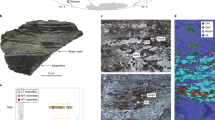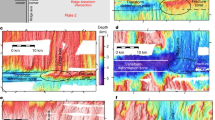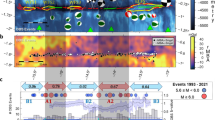Abstract
Oceanic transform faults are one of the main types of plate boundary, but the manner in which they slip remains poorly understood. Early studies suggested that relatively slow earthquake rupture might be common1,2; moreover, it has been reported that very slow slip precedes some oceanic transform earthquakes, including the 1994 Romanche earthquake3,4,5. The presence of such detectable precursors would have obvious implications for earthquake prediction. Here we model broadband seismograms of body waves to obtain well-resolved depths and rupture mechanisms for 14 earthquakes on the Romanche and Chain transform faults in the equatorial Atlantic Ocean. We found that earthquakes on the longer Romanche transform are systematically deeper than those on the neighbouring Chain transform. These depths indicate that the maximum depth of brittle failure is at a temperature of ∼600 °C in oceanic lithosphere. We find that the body waves from the Romanche 1994 earthquake can be well modelled with relatively deep slip on a single fault, and we use the mechanism and depth of this earthquake to recalculate its source spectrum. The previously reported slow precursor can be explained as an artefact of uncertainties in the assumed model parameters.
This is a preview of subscription content, access via your institution
Access options
Subscribe to this journal
Receive 51 print issues and online access
$199.00 per year
only $3.90 per issue
Buy this article
- Purchase on Springer Link
- Instant access to full article PDF
Prices may be subject to local taxes which are calculated during checkout





Similar content being viewed by others
References
Kanamori, H. & Stewart, G. S. Mode of the strain release along the Gibbs fracture zone, Mid-Atlantic Ridge. Phys. Earth Planet. Inter. 11, 312–332 (1976).
Okal, E. A. & Stewart, L. M. Slow earthquakes along oceanic fracture zones: evidence for aesthenospheric flow away from hotspots? Earth Planet. Sci. Lett. 57, 75–87 (1992).
Ihmlé, P. F. & Jordan, T. M. Teleseismic search for slow precursors to large earthquakes. Science 266, 1547–1551 (1994).
McGuire, J. J., Ihmlé, P. F. & Jordan, T. H. Time domain observations of a slow precursor to the 1994 Romanche transform earthquake. Science 274, 82–85 (1996).
Ihmlé, P. F., Harabaglia, P. & Jordan, T. H. Teleseismic detection of a slow precursor to the great 1989 Macquarie Ridge earthquake. Science 261, 177–183 (1993).
Sibson, R. H. Fault zone models, heat flow and the depth distribution of earthquakes in the continental crust of the United States. Bull. Seismol. Soc. Am. 72, 151–163 (1982).
Wiens, D. A. & Stein, S. Age dependence of oceanic intraplate seismicity and implications for lithospheric evolution. J. Geophys. Res. 88, 6455–6468 (1983).
Engeln, J. F., Wiens, D. A. & Stein, S. Mechanisms and depths of Atlantic transform faults. J. Geophys. Res. 91, 548–577 (1986).
Bergman, E. A. & Solomon, S. C. Transform fault earthquakes in the North Atlantic: source mechanisms and depth of faulting. J. Geophys. Res. 93, 9027–9057 (1988).
Wilcock, W. S. D., Purdy, G. M. & Solomon, S. C. Microearthquake evidence for extensions across the Kane transform fault. J. Geophys. Res. 95, 15439–15462 (1990).
Kanamori, H. & Kikuchi, M. The 1992 Nicaragua earthquake: a slow tsunami earthquake associated with subducted sediments. Nature 361, 714–716 (1993).
Kedar, S., Watada, S. & Tanimoto, T. The 1989 Macquarie Ridge earthquake: seismic moment estimation from long period free oscillations. J. Geophys. Res. 99, 17893–17907 (1994).
Velasco, A. A., Ammon, C. J. & Lay, T. Source time function complexity of the great 1989 Macquarie Ridge earthquake. J. Geophys. Res. 100, 3989–4009 (1995).
Silver, P. G. & Jordan, T. H. Total-moment spectra of fourteen large earthquakes. J. Geophys. Res. 88, 3273–3293 (1983).
Dziewonski, A. M. & Woodhouse, J. H. An experiment in systematic study of global seismicity: centroid-moment tensor solutions for 201 moderate and large earthquakes of 1981. J. Geophys. Res. 88, 3247–3271 (1983).
Dziewonski, A. M., Ekström, G. & Maternovskaya, N.-N. Centroid-moment tensor solutions for October–December. Phys. Earth Planet. Inter. 115, 1–16 (1999).
Abercrombie, R. E. & Mori, J. J. Local observations of the onset of a large earthquakes: 28 June 1992 Landers, California. Bull. Seismol. Soc. Am. 84, 725–734 (1994).
Wesnousky, S. G. Seismological and structural evolution of strike-slip faults. Nature 335, 340–343 (1988).
Harris, R. A. & Day, S. M. Dynamic 3D simulations of earthquakes on en echelon faults. Geophys. Res. Lett. 26, 2089–2092 (1999).
Dziewonski, A. M. & Anderson, D. L. Preliminary reference Earth model. Phys. Earth Planet. Inter. 2, 297–356 (1981).
Kanamori, H. & Anderson, D. L. Theoretical basis for some empirical relations in seismology. Bull. Seismol. Soc. Am. 65, 1073–1095 (1975).
Chen, Y. Thermal model of oceanic transform faults. J. Geophys. Res. 93, 8839–8851 (1988).
Detrick, R. S., White, R. S. & Purdy, G. M. Crustal structure of North Atlantic fracture zones. Rev. Geophys. 31, 439–458 (1993).
Brune, J. N. Seismic moment, seismicity and rate of slip along major fault zones. J. Geophys. Res. 73, 777–784 (1968).
DeMets, C., Gordon, R. G., Argus, D. F. & Stein, S. Current plate motions. Geophys. J. Int. 101, 425–478 (1990).
Smith, W. H. F. & Sandwell, D. T. Global sea floor topography from satellite altimetry and ship depth soundings. Science 277, 1956–1962 (1997).
Wessel, P. & Smith, W. H. F. Free software helps map and display data. Eos 72, 441, 445–446 (1991).
Ekström, G. A very broadband inversion method for the recovery of earthquake source parameters. Tectonophysics 166, 73–100 (1989).
Antolik, M., Kaverina, A. & Dreger, D. Compound rupture of the great 1998 Antarctic plate earthquake. J. Geophys. Res. 105, 23825–23838 (2000).
McKenzie, D. P. Speculations on the consequences and causes of plate motions. Geophys. J. R. Astron. Soc. 18, 1–32 (1969).
Acknowledgements
We thank M. Antolik for assistance with the slip inversion, and J. Tromp for discussion.
Author information
Authors and Affiliations
Corresponding author
Rights and permissions
About this article
Cite this article
Abercrombie, R., Ekström, G. Earthquake slip on oceanic transform faults. Nature 410, 74–77 (2001). https://doi.org/10.1038/35065064
Received:
Accepted:
Issue Date:
DOI: https://doi.org/10.1038/35065064
This article is cited by
-
Fluid-assisted grain size reduction leads to strain localization in oceanic transform faults
Nature Communications (2023)
-
Broad fault zones enable deep fluid transport and limit earthquake magnitudes
Nature Communications (2023)
-
Deep hydration and lithospheric thinning at oceanic transform plate boundaries
Nature Geoscience (2022)
-
Oceanic transform fault seismicity and slip mode influenced by seawater infiltration
Nature Geoscience (2021)
-
Extensional tectonics and two-stage crustal accretion at oceanic transform faults
Nature (2021)
Comments
By submitting a comment you agree to abide by our Terms and Community Guidelines. If you find something abusive or that does not comply with our terms or guidelines please flag it as inappropriate.



